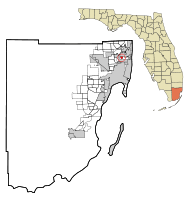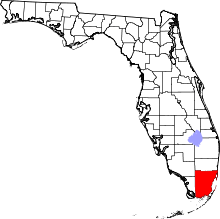Biscayne Park, Florida
| Village of Biscayne Park Biscayne Park | |
|---|---|
| Village | |
|
The historic Village Hall Log Cabin, which serves as Commission chambers for all meetings, as well as other Board meetings, and for special events. | |
 Location in Miami-Dade County and the state of Florida | |
 U.S. Census Bureau map showing village boundaries | |
| Coordinates: 25°52′18.62″N 80°10′55.13″W / 25.8718389°N 80.1819806°WCoordinates: 25°52′18.62″N 80°10′55.13″W / 25.8718389°N 80.1819806°W | |
| Country |
|
| State |
|
| County |
|
| Incorporated (town) | December 31, 1931 |
| Incorporated (village) | June 16, 1933 |
| Government | |
| • Type | Council-Manager |
| • Mayor | David J. Coviello |
| • Vice Mayor | Roxanna Ross |
| • Commissioners | Bob Anderson, Fred Jonas, and Barbara Watts. Our demographics are from 2000 and hopelessly outdated. Update coming soon. |
| • Village Clerk | Maria C. Camara |
| Area | |
| • Village | 0.6 sq mi (1.6 km2) |
| • Land | 0.6 sq mi (1.6 km2) |
| • Water | 0 sq mi (0 km2) 0% |
| Elevation | 7 ft (2 m) |
| Population (2015) | |
| • Village | 3,147 |
| • Density | 4,843.1/sq mi (1,869.9/km2) |
| • Metro | 5,564,635 |
| Time zone | EST (UTC-5) |
| • Summer (DST) | EDT (UTC-4) |
| Zip Code | 33161 |
| Area code(s) | 305, 786 |
| FIPS code | 12-06600[1] |
| GNIS feature ID | 0278854[2] |
| Website | http://www.biscayneparkfl.gov/ |
Biscayne Park is a village in Miami-Dade County, Florida, United States. Biscayne Park was developed in the 1920s by Arthur Griffing. Biscayne Park was originally a neighborhood of the City of Miami when it was annexed into the City of Miami in 1925. With the arrival of the Great Depression, the City of Miami gave up its jurisdiction and Biscayne Park was incorporated as its own town in 1931. In 1933, the town decided to become a village, and changed its name to the Village of Biscayne Park.
Geography
Biscayne Park is located at 25°52′55″N 80°10′51″W / 25.88194°N 80.18083°W (25.881972, -80.180868).[3] According to the United States Census Bureau, the village has a total area of 0.6 square miles (1.6 km2), all land.
Surrounding areas
- North Miami
- North Miami


 North Miami
North Miami - Unincorporated Miami-Dade County

 Unincorporated Miami-Dade County
Unincorporated Miami-Dade County - Miami Shores


 Miami Shores
Miami Shores - Miami Shores
Demographics
| Historical population | |||
|---|---|---|---|
| Census | Pop. | %± | |
| 1940 | 500 | — | |
| 1950 | 2,009 | 301.8% | |
| 1960 | 2,911 | 44.9% | |
| 1970 | 2,717 | −6.7% | |
| 1980 | 3,088 | 13.7% | |
| 1990 | 3,068 | −0.6% | |
| 2000 | 3,269 | 6.6% | |
| 2010 | 3,055 | −6.5% | |
| Est. 2015 | 3,216 | [4] | 5.3% |
| Biscayne Park Demographics | |||
|---|---|---|---|
| 2010 Census | Biscayne Park | Miami-Dade County | Florida |
| Total population | 3,055 | 2,496,435 | 18,801,310 |
| Population, percent change, 2000 to 2010 | -6.5% | +10.8% | +17.6% |
| Population density | 4,843.1/sq mi | 1,315.5/sq mi | 350.6/sq mi |
| White or Caucasian (including White Hispanic) | 72.4% | 73.8% | 75.0% |
| (Non-Hispanic White or Caucasian) | 43.4% | 15.4% | 57.9% |
| Black or African-American | 17.6% | 18.9% | 16.0% |
| Hispanic or Latino (of any race) | 35.2% | 65.0% | 22.5% |
| Asian | 3.3% | 1.5% | 2.4% |
| Native American or Native Alaskan | 0.2% | 0.2% | 0.4% |
| Pacific Islander or Native Hawaiian | 0.1% | 0.0% | 0.1% |
| Two or more races (Multiracial) | 3.6% | 2.4% | 2.5% |
| Some Other Race | 2.8% | 3.2% | 3.6% |
As of 2010, there were 1,324 households out of which 9.3% were vacant. In 2000, 31.3% had children under the age of 18 living with them, 44.9% were married couples living together, 14.8% had a female householder with no husband present, and 35.2% were non-families. 25.0% of all households were made up of individuals and 7.2% had someone living alone who was 65 years of age or older. The average household size was 2.55 and the average family size was 3.12.
In 2000, the village population was spread out with 23.8% under the age of 18, 6.3% from 18 to 24, 34.1% from 25 to 44, 24.6% from 45 to 64, and 11.3% who were 65 years of age or older. The median age was 37 years. For every 100 females there were 93.5 males. For every 100 females age 18 and over, there were 89.8 males.
In 2000, the median income for a household in the village was $48,313, and the median income for a family was $53,409. Males had a median income of $39,964 versus $33,125 for females. The per capita income for the village was $22,923. About 9.5% of families and 12.0% of the population were below the poverty line, including 18.8% of those under age 18 and 7.3% of those age 65 or over.
As of 2000, speakers of English as a first language was at 59.60%, with Spanish at 29.27%, French Creole at 9.40%, and French at 1.74% of the population.[6]
As of 2000, Bisacyne Park had the seventy-third highest percentage of Colombian residents in the US, with 2.05% of the US populace.[7] It had the fifty-seventh highest percentage of Cuban residents in the US, at 6.64% of the village's population,[8] and the seventeenth highest percentage of Haitian residents in the US, at 9.20% of the its population.[9] It also had the fourteenth highest percentage of Peruvians, at 2.48% of all residents (tied with Glen Cove, New York,) [10] while Biscayne Park's Honduran community had the twenty-sixth highest percentage of residents, which was at 1.38% of the population.[11] It is also home to the nineteenth highest percentage of Lebanese residents in the US, at 1.70% of the population (tied with nine other US areas, which included Tierra Verde, FL.)[12]
Taxes
For fiscal year 2015-16, Biscayne Park has a millage rate of 9.7000, and a combined millage rate of 26.02930.
References
- ↑ "American FactFinder". United States Census Bureau. Archived from the original on 2013-09-11. Retrieved 2008-01-31.
- ↑ "US Board on Geographic Names". United States Geological Survey. 2007-10-25. Retrieved 2008-01-31.
- ↑ "US Gazetteer files: 2010, 2000, and 1990". United States Census Bureau. 2011-02-12. Retrieved 2011-04-23.
- ↑ "Annual Estimates of the Resident Population for Incorporated Places: April 1, 2010 to July 1, 2015". Retrieved July 2, 2016.
- ↑ "Census of Population and Housing". Census.gov. Archived from the original on May 11, 2015. Retrieved June 4, 2015.
- ↑ "MLA Data Center Results of Biscayne Park, FL". Modern Language Association. Retrieved 2007-10-29.
- ↑ "Ancestry Map of Colombian Communities". Epodunk.com. Retrieved 2007-10-29.
- ↑ "Ancestry Map of Cuban Communities". Epodunk.com. Retrieved 2007-10-29.
- ↑ "Ancestry Map of Haitian Communities". Epodunk.com. Retrieved 2007-10-29.
- ↑ "Ancestry Map of Peruvian Communities". Epodunk.com. Retrieved 2007-10-29.
- ↑ "Ancestry Map of Honduran Communities". Epodunk.com. Retrieved 2007-10-29.
- ↑ "Ancestry Map of Lebanese Communities". Epodunk.com. Retrieved 2007-10-29.
External links
- Village of Biscayne Park official site
.jpg)
